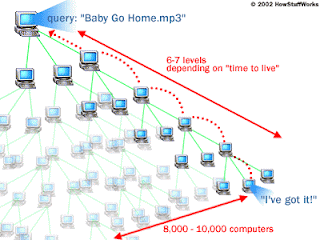CyberpunkNet Search

Monday, September 1, 2008
Wednesday, August 13, 2008
Defcon Subway Hack Document
Here is the story on the subway card hacking by MIT students along with the banned document slide show they were told not to show.
Judge orders halt to Defcon speech on subway card hacking
MIT students Alessandro Chiesa, R.J. Ryan, Zack Anderson, and Electronic
Frontier Foundation staff attorney Kurt Opsahl speakat a panel turned press
conference at Defcon. (Credit: Declan McCullagh/CNET News) LAS
VEGAS--A federal judge on Saturday granted the Massachusetts transit
authority's request for an injunction preventing three MIT students from
giving a presentation about hacking smartcards used in the Boston subway
system.The Electronic Frontier Foundation, which is representing the
students, anticipates appealing the ruling, said EFF senior staff attorney Kurt
Opsahl. The undergraduate students had been scheduled to give a
presentation Sunday afternoon at the Defcon hacker conference here that
they had said would describe "several attacks to completely break the
CharlieCard," an RFID card that the Massachusetts Bay Transportation
Authority uses on the Boston T subway line. They also planned to release
card-hacking software they had created, but canceled both the presentation
and the release of the software. U.S. District Judge Douglas Woodlock on
Saturday ordered the students not to provide "program, information, software
code, or command that would assist another in any material way to circumvent
or otherwise attack the security of the Fare Media System." Woodlock
granted the MBTA's request after a hastily convened hearing
in Massachusetts that took place at 8 a.m. PDT on Saturday. EFF staff
attorney Kurt Opsahl said that the temporary restraining order is "violating their
First Amendment rights"; another EFF attorney said a court order pre-emptively
gagging security researchers was "unprecedented." EFF attorneys appeared with
the three students--Zack Anderson, R.J. Ryan, and Alessandro Chiesa--in front
of a crowd of hundreds at an afternoon session at Defcon, but largely prevented
them from answering questions, citing the lawsuit. Although Sunday's talk is
canceled, Defcon organizers hinted that there may be a related presentation on a
similar topic.
Banned Slide Here
Continue Story Here
Wednesday, July 23, 2008
Shadow life, First Step In Hacking Anonymously

This article is for informational and educational purposes only. I am not responsible for anything you may choose to do with this information. Remember: identity theft and money laundering are ILLEGAL.
In this article, I will attempt to outline the basic techniques for creating an alias. These are just the basics, but remember that based on these basic principals is the foundation that are made to be built upon. There are two part to an alias, one being the persona you wish to make for your self, and the other is the identity. This article will talk about the identity, you can choose the persona you wish to make.
1) Choose a Name: You need to choose a name that is common. One that is hard to track or investigated. Basically a name that hides it self. Search the web and white pages for common names that are used in your area. Try to choose one that was popular around the year you were born. And last make sure to choose a first and last name combination that is really common. For example, if you live in an area that is heavily populated with white people, choose a white common name, like John Smith. But if it is heavily populated by Mexicans, then choose something like Jose Gonzales, get the idea?
Next Choose a handle, a nick name that you will be Under. Multi Layered Aliases work best to hide ones identity.
2)Next either from a library, school network or free hot spot go online and create an e-mail address. Create an new e-mail address with your new Alias. If you don't want to use your real e-mail to create your new one, try going to www.hushmail.com to create an e-mail address.
3)After creating your Alias and e-mail address you will want to put your alias in the "system", meaning create a paper trail. Go Ahead and join Social network sites with your new alias and e-mail account. Join several not just one, also go ahead and join Message boards and any other site that requires membership.
The second part to getting your alias into the system is to buy prepaid visa and master cards, terrorist buy these in bulk to launder money and purchase items online, once you have the pre-paid cards do all your shopping online and use your alias to do the shopping. Try to send items to multiple locations when purchasing these items, like to friends or neighbors addresses two streets down, then track your order and go pick up your item with the excuse that the carrier accidentally delivered it to their house.
4) Get a pre-paid phone and use your alias for all the info, most times an address is not required but if it is just give a fake one. Do not give this number out to any friends or people that know you, use this number when ordering online or to contact people that know you as your alias.
These are the basic principals for an alias, either for social engineering or to cover up your tracks in case the shit hits the fan.
I am not responsible for any harm that may come from information in this article.Use any info only at your own risk!
Update News
Monday, July 14, 2008
The Nets No. 1 Punk
 share to Morpheus to Lime-Wire just to name a few. He was born in 1978 and grew up in Sedona, Arizona. Frankel took control of his education while using his brother’s 8-bit Atari computer, after that experience he was a self thought wiz by the time he enter high school. At a young age he had a high skill for programming and used it to his advantage.
share to Morpheus to Lime-Wire just to name a few. He was born in 1978 and grew up in Sedona, Arizona. Frankel took control of his education while using his brother’s 8-bit Atari computer, after that experience he was a self thought wiz by the time he enter high school. At a young age he had a high skill for programming and used it to his advantage.“It's 1995, and the high school sophomore is sprinting through a programming contest at the University of Northern Arizona. Frankel, 16, is so far ahead of his nearest competitor that, just for yucks, he decides to write a little "fork bomb" -- a program that splits itself repeatedly until it swamps a computer system. He uploads it, and one by one the machines around him crash. As administrators scramble, he sits in guilty silence, then finally confesses to a frazzled systems engineer ……Frankel wins anyway. “- Timedigital.com
After dropping out of University after two quarters he went home in and spent his time in a 8ft by 12ft room on the computer and listening to music, he started coding one day trying to make a media player with features that no other player had that he wanted, and in 1997 Winamp 1.0 was born. He released the shareware under the moniker he created in high school, Null soft. (The company's name is a parody of Microsoft, from the fact that null (nothing) is smaller than micro). The media player quickly gained popularity and in a year and a half about 15 million people had downloaded the media player. It was a huge success. He was receiving about $8,000 a month just on advertising alone and a percentage of the people had sent in the $10 shareware optional fee. By this time Frankel was getting in tens of thousands of dollars each month. Despite the success Frankel was no sell out. A deal with a pharmaceutical company interested in using Winamp in presentations fell apart because of the fact that he refused to take out the media player’s tag line “Winamp whips the llama’s ass”.

AOL took notice of the popularity of Winamp and Shoutcast and in June 1999 they acquired Nullsoft for $100 million dollars from Frankel. At the same time he was then hired by AOL to further develop Winamp and Shoutcast and was given full control of the development, but this control would lead to rough times.

Frankel while sitting at his cubicle came across Napster, a file-sharing program that was cleverly created by 19 year old Shawn Fanning. Frankel thought to himself "how the hell are they going to keep from getting sued" as Napster stored all their "data" (mp3's) in a centralized location."When Hail to the Thief leaked on the Internet," Frankel says, "I was like, 'Right on!' But I still bought the CD. I think it's wrong to download music and ne
 ver give anything to the artist. But if you download something and you're like, 'This sucks,' and you never listen to it again, I don't think there's anything wrong with that." But this ideology and interest gave birth to something revolutionary called Gnutella.
ver give anything to the artist. But if you download something and you're like, 'This sucks,' and you never listen to it again, I don't think there's anything wrong with that." But this ideology and interest gave birth to something revolutionary called Gnutella.Napster's downfall was that it stored all the music that was being shared in company computers. Napster was capitalizing from copyright infringement and was in the path to legal prosecution by Time Warner. Fra
 nkel decided to fix the problem that Napster had made and decided to make a program that let people share all kinds of files not just music, but videos, documents, images all from a decentralized location. He decided to connect peoples computers directly to each other, they could share information and data with out having to go trough a centralized location."I would not be getting any money from it," he says. "I'd be giving power to people, and what can be wrong with that?" So Frankel started to code fast and under the radar at AOL's Nullsoft offices. He worked fast because if AOL found out they would prevent it from happening. On March 2000, Justin Frankel and Tom Pepper uploaded a beta version of Gnutella on the AOL servers with a note: "Justin and Tom work for Nullsoft, makers of Winamp and Shoutcast. See? AOL can bring you good things!" The next day Frankel was with his parents touring Alcatraz, when his cell phone rang. It was Pepper. "Dude," Pepper said, "you better get back to the office." By the time Frankel got back all hell had broken loose. Time Warner and AOL were about to merge and since Time Warner was in the middle of suing Napster for facilitating copyright infringement, the little self freelance project was a bad timing. AOL made him pull down the software but by the end of the day over 10,000 people had downloaded the beta software and hackers had gone to work to reverse-engineer it and throw it into the hands of the open-source community, this laid the foundation for BearShare, Morpheus, LimeWire and other file-trading software. The biggest strength that came from Gnutella was that once it started it could never be shut down, unlike Napster. The only way to stop Gnutella is to shut down all the computers in the world running it and that would be impossible to do.
nkel decided to fix the problem that Napster had made and decided to make a program that let people share all kinds of files not just music, but videos, documents, images all from a decentralized location. He decided to connect peoples computers directly to each other, they could share information and data with out having to go trough a centralized location."I would not be getting any money from it," he says. "I'd be giving power to people, and what can be wrong with that?" So Frankel started to code fast and under the radar at AOL's Nullsoft offices. He worked fast because if AOL found out they would prevent it from happening. On March 2000, Justin Frankel and Tom Pepper uploaded a beta version of Gnutella on the AOL servers with a note: "Justin and Tom work for Nullsoft, makers of Winamp and Shoutcast. See? AOL can bring you good things!" The next day Frankel was with his parents touring Alcatraz, when his cell phone rang. It was Pepper. "Dude," Pepper said, "you better get back to the office." By the time Frankel got back all hell had broken loose. Time Warner and AOL were about to merge and since Time Warner was in the middle of suing Napster for facilitating copyright infringement, the little self freelance project was a bad timing. AOL made him pull down the software but by the end of the day over 10,000 people had downloaded the beta software and hackers had gone to work to reverse-engineer it and throw it into the hands of the open-source community, this laid the foundation for BearShare, Morpheus, LimeWire and other file-trading software. The biggest strength that came from Gnutella was that once it started it could never be shut down, unlike Napster. The only way to stop Gnutella is to shut down all the computers in the world running it and that would be impossible to do.AOL kept him on "a very short leash," after that. They steered him away from interviewers and encouraging him to focus on Winamp the software they ad paid him for. Not surprisingly, he acted out. In August 2000, he uploaded an MP3 search engine. AOL took it down. The next month, he uploaded program called AIMazing, which would replace the banner ads in AOL's Instant Messenger. Frankel called it nothing more than "a cute innovation." The Wall Street Journal called Frankel "AOL's loose cannon."... "We fought off the AOL bullshit as much as possible," Frankel says. When the company tried to insist that an AOL icon instantly appear on a user's desktop during a Winamp installation, Frankel hit the roof. "I'd be like, 'Look, our users don't want to use AOL!' " he says. " 'They think AOL sucks!'"
While AOL's mediaplyer Winamp lost popularity to that of Windows Media Player and RealPlayer Frankel started coding a new kind of software called Waste: a "private workspace," as he calls it, that allows small groups of friends to trade files without being as conspicuous as those on the larger peer-to-peer networks, they are sometimes called darknets and are hard to get into because you cant get in unless you are invited. The most skilled hackers; or recording-industry rats, would have trouble figuring out when or where a Waste system is running.
This time around, Frankel tried to do it the correct way by trying to pitching Waste to AOL, instead AOL pushed it to the side and left it there. Frankel got fed up and on May 28th, 2003, four years to the date that he was acquired, Frankel rebelled again, uploading Waste as a way to force AOL to deal with it, and him. But once again AOL took the program down.
AOL watched Frankel very closely after that, taking down other projects that he tried to release to the public, including an MP3 search engine and a patch for AIM calle AIMazing to block advertisements in the application. Frankel stayed with AOL in order to complete Winamp version 5.0, a hybrid of the Winamp v2.x series and Winamp v3. On December 2003 AOL shut down Nullsoft's San Francisco offices and laid off 450 employees.
Frankel announced his resignation from AOL on Januarry 2004 on his blog.
Sunday, July 13, 2008
Partner Blog P2PNetNews.blogspot.com
for links, news, and downloads to great content. A blog that helps the spread of information and data with out restrictions.
And at www.netmesh.blogspot.com
for videos, pictures and stories around the net.


